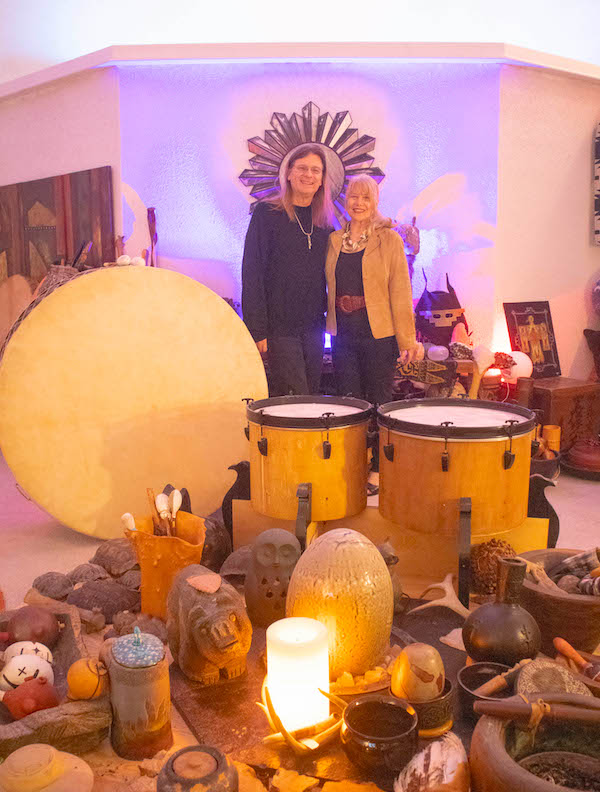
KEY DISCOVERIES of Felicitas D. Goodman, Founder of the Cuyamungue Institute (CI)
by Laura Lee, Director of Research & Outreach, Cuyamungue Institute, copyright 2012
Hosting a nationally syndicated radio talk show afforded us the opportunity to talk with the world’s leading edge. This was that path that led my husband Paul and I to anthropologist Dr. Goodman, and her life-changing work in 1994, and we worked with her for over a decade before her passing. We eventually left radio to head up the Cuyamungue Institute (CI), the 501-c-3 research organization Goodman founded to continue research into the foundational discoveries she made. This work lies at the core of the intellectual property she bequeathed CI, the spiritual practice she called Ritual Body Postures for Ecstatic Trance. Here are my favorites among her many insights.
Mystical experiences are normal, natural, and achievable by all — via a normal and natural physiological shift, easily accessible to everyone with a healthy nervous system. Such states are our birthright, built into our DNA, independent of any one belief system or dogma.
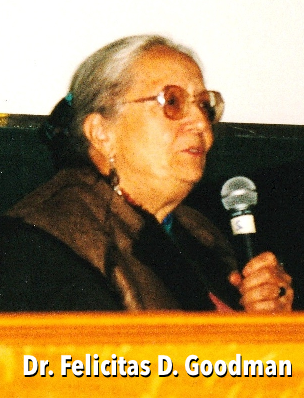 Entering into visionary states is based not upon a belief system, but a physiological shift. While activation of this shift is normal, natural, and healthy, it is no longer common in our culture today. While plant medicine and psychedelics work, they are not the only pathway. Our bodies are quite capable of manufacturing its own internal, endogenous entheogens when given the prompts to do so.
Entering into visionary states is based not upon a belief system, but a physiological shift. While activation of this shift is normal, natural, and healthy, it is no longer common in our culture today. While plant medicine and psychedelics work, they are not the only pathway. Our bodies are quite capable of manufacturing its own internal, endogenous entheogens when given the prompts to do so.
Ritual is one of the prompts, and can activate these states. Dr. Goodman gave our modern era a path to reclaim our long-lost indigenous roots, without cultural appropriation. To open the portal to an Alternate Reality, she took not one culture’s ritual, but the world’s collection of rituals, and cooked them down to the steps they all had in common. In the short list, the essential, pivotal steps remain, that give us a universal protocol for this ritual, thus continuing a very ancient legacy.
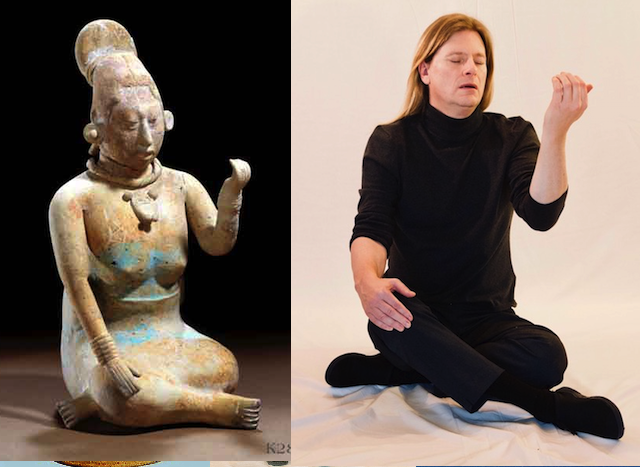 Ritual Instructions for Spirit Journeys are encoded in select ancient art the world over. To this ritual to open the portal, Dr. Goodman added another key insight: select artwork from these early cultures demonstrate how to hold our bodies during 15 minutes of “sonic driving.” Goodman used a fast, monotone beat with a skin drum or gourd rattle for the sound induction, and drew up a canon of Ritual Body Postures, as she called them, from select ancient art the world over. These artifacts depict humans, and sometimes spirit animals, standing, or sitting — in chairs, cross-legged on the ground, or kneeling, with arms and hands placed just so — in postures that aren’t relaxed, but intentional. Our ancestors used the language of art to encode in plain sight, a message that we can decode across the eons. The earliest of the Cuyamungue Institute canon of postures traces back to artifacts created during the Ice Age, some 40,000 years old.
Ritual Instructions for Spirit Journeys are encoded in select ancient art the world over. To this ritual to open the portal, Dr. Goodman added another key insight: select artwork from these early cultures demonstrate how to hold our bodies during 15 minutes of “sonic driving.” Goodman used a fast, monotone beat with a skin drum or gourd rattle for the sound induction, and drew up a canon of Ritual Body Postures, as she called them, from select ancient art the world over. These artifacts depict humans, and sometimes spirit animals, standing, or sitting — in chairs, cross-legged on the ground, or kneeling, with arms and hands placed just so — in postures that aren’t relaxed, but intentional. Our ancestors used the language of art to encode in plain sight, a message that we can decode across the eons. The earliest of the Cuyamungue Institute canon of postures traces back to artifacts created during the Ice Age, some 40,000 years old.
What led Goodman to these ground-breaking insights?
As a linguist who spoke and wrote eight languages, Goodman joined a groundbreaking study when her mentor, cultural anthropologist Erika Bourguignon, hired her to translate a number of the ethnographies collected in a National Institute of Mental Health survey of indigenous cultures worldwide. The study’s conclusion — that over 95% of cultures held visionary practices as sacred, healthy, and central to the ‘glue’ that held them together — helped legitimize consciousness raising studies in the 1960’s. As Goodman was translating, she compiled a list of what all these practices had in common for her own research. By stripping away cultural overlay, a series of simple, essential and familiar steps emerged: Set aside a sacred space. Expect good results. Prepare oneself. Call the spirits with an offering, for when calling on the participation of a higher order, we show a measure of respect and reciprocity. A fast, rhythmic, monotone beat, provided by singing, chanting, drum, or rattle, is the ‘sonic driving’ that activates the shift across the threshold in non-ordinary reality. When that ceases, the body naturally returns to our ordinary waking state. With a gesture of thanks, the ritual has concluded.
Goodman’s hunch, that entering into visionary states is based not upon a belief system, but a physiological shift, took another leap forward with a colleague’s report that sitting in a yoga pose for five minutes resulted in measurable physiological shifts. This was her Aha Moment: holding a specific posture can affect the physiology? As her speciality was the earliest indigenous and hunter-gather societies, she went looking for the postures that were meaningful to those cultures, as recorded in those ancient artifacts. Clues in the artwork, such as “that unmistakable look of the inward gaze” became readily apparent in her search for sitting and standing postures that she decoded as “ritual instruction” — a total of 60 postures, found again and again in cultures widely separated through geography and era. By this time she was teaching anthropology at Denison University in Ohio, and her students were demanding, “you say that there is a way to achieve visionary states without drugs? let us try!”
With a small grant she continued her experiment, conducting the ritual while asking volunteers to stand in the posture she demonstrated for the 15-minute duration of the sonic driving. With this, Goodman found what she had been looking for — truly an “ecstatic trance journey”, wholly within the body’s own capacity and without drugs or botanicals. Such journeys were long thought to be the realm of mystics only, but Goodman found that this was achievable by anyone with a healthy nervous system and right access codes.
In 1983 she was invited to test her theories in the labs of Johann Kugler at the University of Munich. They found this natural, easy physiological shift included some unusual findings: Blood pressure dropped (within safe limits) yet pulse rate rose (to levels ordinarily achieved by running very fast). EEG tests showed the continuous stream of Beta Waves (those of ordinary, waking state) joined simultaneously by Theta Waves (those of deep-sleep dreaming). Blood tests revealed a decrease in cortisol, the stress hormone, and a surge of beta endorphins, the feel-good hormones. She felt the academic term “ecstatic trance” with the etymology from the Greek Ekstasis, “to be or stand outside oneself, a removal to elsewhere” nicely described the experiential journey to another realm and back, as well as underscoring the resulting feeling of elation and bliss.
Cuyamungue Institute Directors Laura Lee and Paul Robear Continue the Research
“So what is this physiological shift that gives rise to this visionary state?” we asked Dr. Geert Meyer, who had just spent the week with us at CI testing this out. An Associate Professor in Neurology at the Philipps University in Marburg/Germany, a brain-mind specialist in sleep and dreaming, he was impressed by our work, and offered this explanation:
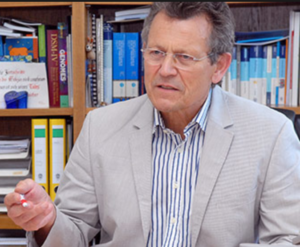
“It’s extraordinary that our ancestors so far back developed this simple ritual to activate some of the centers in the brain responsible for dreaming, while we are still awake. Extraordinary! Usually those two centers do not talk to one another, as one is turned off while the other is turned on. So what we have here is an expanded state of awareness, with both the waking and dreaming centers active and talking at the same time. This a kind of “waking dream. It’s not lucid dreaming, but this is cut of the same cloth. And to find that humans had techniques to activate this so long ago is extraordinary! It’s the hybrid state of simultaneous waking and dreaming.”
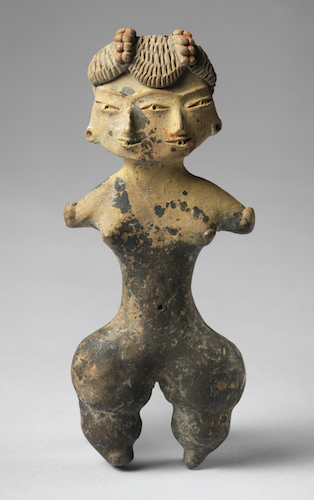 Here’s a beautiful example of the broad range of information that an artifact can convey. This Tlatilco artifact was a favorite of Dr. Goodman’s. She cited it as cogently and elegantly conveying in the two realms simultaneously — our 0rdinary reality and the alternate, non-ordinary reality. Just as Geert describes as a neurologist. It’s such an expanded, sensory and emotionally fulfilling experience to have foot in both worlds.
Here’s a beautiful example of the broad range of information that an artifact can convey. This Tlatilco artifact was a favorite of Dr. Goodman’s. She cited it as cogently and elegantly conveying in the two realms simultaneously — our 0rdinary reality and the alternate, non-ordinary reality. Just as Geert describes as a neurologist. It’s such an expanded, sensory and emotionally fulfilling experience to have foot in both worlds.
We call this a “trance” because we have lost the language for any state outside our preferred rational thinking. This is not a diminished state, but a more fully engaged state, with more brain activity supporting it — one is fully awake and aware, while simultaneously engaged in an inward journey of surprising and vivid dimensions.
Science Today Confirms a small part of what our Ancestors Knew Long Ago
New research reveals that holding specific postures results in physiological shifts. In Amy Cuddy’s book “Presence: Bringing Your Boldest Self to Your Biggest Challenges”. she cites tests that revealed a 19% increase in testosterone and 25% decrease in cortisol by simply standing for two minutes in the “Wonder Woman” pose with hands on hips, chin tilted upwards, feet planted wide apart. The notion that body postures affect our physiology hit home with the general population. Cuddy’s TED talk, “Empowering Through Body Language” is the second most popular with 46 million views.
Might we instinctively know this on some level? Then its not that far a leap to imagine our ancient ancestors knew this long ago. There is a proliferation of ancient artifacts depicting this posture across many cultures and eras. Here at CI, this has been one of our favorite CI postures for over forty years. What’s interesting is that when part of the CI ritual, the experience goes far beyond a rise in testosterone and feeling empowered — it leads to a visionary journey that is quite profound.
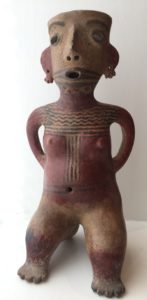
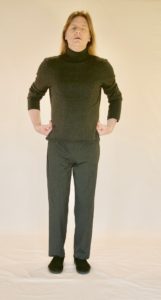
Background and History of Dr. Felicitas Goodman – More Information
Goodman’s book, “Where the Spirits Ride the Wind” tells the story of her discoveries and research in full.
